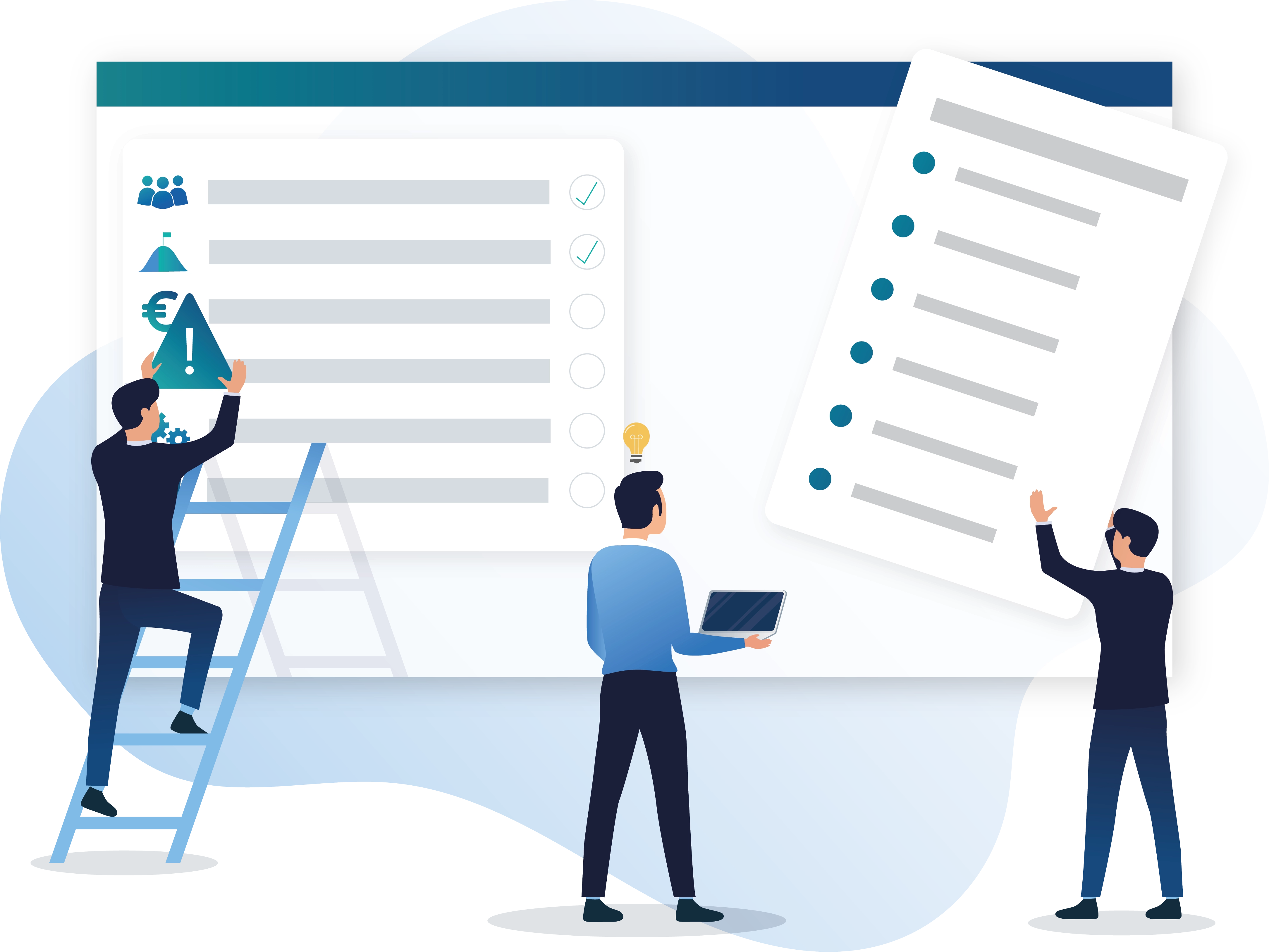BIC Process Design
Understand & Transform
Supercharge your business operations with the most intuitive AI-powered BPM software.
It seems that you come from a German speaking country. Here you can change the language
EnglishRisk management (also known as Enterprise Risk Management or ERM) helps companies effectively deal with uncertainties and the associated risks and opportunities, thereby increasing value creation potential. Using modern risk management software makes this process even easier and more effective. The real benefit comes when management carefully aligns strategy, goals, and resources to find an optimal balance between growth, profits, and the risks involved.

Table of Contents
Author
Philipp Strokosch

Every business faces a variety of risks in its daily operations. The bigger the company, the more international its activities, and the more complex its supply and production chains, the more challenging the risk landscape becomes. At the same time, legal requirements also increase. These risks can be financial, operational, technological, or regulatory, oftentimes impacting critical areas such as data protection, information security, or the environmental and social sustainability of business practices.
To deal with these challenges effectively, companies need a solid risk management system –often referred to as Enterprise Risk Management (ERM). ERM is a structured process that helps identify, assess, and manage all risks that could potentially harm a company’s success. Ideally, those risks are spotted early so that businesses can take proactive steps to minimize or even prevent negative outcomes.
That’s why risk management is such a crucial part of any successful business strategy. It helps companies stay compliant with regulations, remain agile and responsive in uncertain times, and build long-term trust with customers, partners, and investors.
Modern risk management, however, goes even further: It not only addresses potential threats but also reveals strategically important opportunities. That’s why more and more companies are turning to integrated risk and opportunity management as a more holistic approach that creates maximum transparency and supports better, more future-oriented decisions.


Aligning Goals with the Risk Appetite
Risk management considers the amount of risk the company is willing to take when setting strategic goals and finding ways to manage the associated risks.

Making Well-Founded Decisions
Risk management helps to identify risks precisely and to take the appropriate measures to deal with them: risk avoidance, mitigation, sharing, or acceptance.

Reducing Financial Loss
Organizations can identify potential events earlier and plan how to respond to them in advance. This minimizes surprises and reduces the associated costs and losses.

Managing Risks Comprehensively
Every organization faces a variety of risks that affect different business areas. Risk management allows targeted measures to be taken to counteract these overriding risks.

Uncovering Opportunities
By considering a range of potential risk scenarios, the organization's management is able to identify opportunities and use them proactively.

Improving Use of Capital
By receiving extensive and reliable risk information, management can better assess overall capital needs and thus improve the allocation of capital.

When introducing risk management (aka Enterprise Risk Management or ERM), key success factors and potential challenges need to be taken into account right from the start. A thoughtful and structured approach ensures that risk management is not perceived as a mere compliance obligation but as a strategic value driver. This includes aligning with the expectations and goals of senior leadership while also actively engaging the teams on the frontline, commonly referred to as the 1st Line of Defense.
The objective is to establish ERM as an integrated part of the organizational mindset. For this to happen, leadership must not only endorse the program but visibly support and participate in its implementation. Equally important is creating awareness and fostering ownership among operational staff, as their day-to-day insights are of paramount importance for identifying risks early so they can be addressed appropriately and in a timely manner.
This dual commitment – from the top and bottom of the organization – also plays a decisive role in the continuous improvement of risk management practices. When management and the 1st Line of Defense show commitment and actively participate in the process, only the sky is the limit. To ensure long-term effectiveness, it is equally vital to apply the established risk management framework consistently throughout the organization - regardless of regional differences, business units, or varying corporate cultures. Only with such consistency can risk management unfold its full impact and become a sustainable element of corporate governance.
To start off with ERM, Excel solutions can be used initially. But as soon as the processes involved become larger and more complex, this method becomes cumbersome and extremely error-prone (see Excel vs. specialized risk management software). A professional risk management tool, on the other hand, helps avoid repeating work, saves time, and provides insightful reports that are a real value-add to the company, supporting management in its strategic decision-making. Here's what bringing in a dedicated risk management software allows you to do:

Curious about the value our software can bring to your organization? Our experts will provide a personalized walkthrough, showcasing how our solutions empower over 2,000 customers to achieve their transformation goals and peak performance. See it live in action and discover its impact firsthand!
For a solid and lasting risk management strategy in your company, it is advisable to choose a reliable and mature risk management software. This software can mirror your current processes and give you a method that matches today's standards, like ISO. Here is what you gain:
Modern risk management brings together skills, methods, processes, and tools. This lets organizations meet their goals reliably and handle uncertainties with confidence.

With the world getting more connected, markets opening up, and cost pressures growing, many companies have come to realize that they need structured risk management. But risk management is not only a matter of personal preference; legal compliance demands it. Here are a few examples from the DACH region:
To meet both legal and internal company requirements, it is not sufficient to look at individual risks one by one. A better way is to opt for an integrated approach that lets you look at risks in a bigger picture, incorporating risk management into overall company management and keeping in line with company objectives.
This is where a risk-based approach comes in: This approach should be firmly woven into the organization through risk management software and become an integral part of the company's way of doing things. Getting employees on board is key here – their involvement ensures that the evolving risk management processes are put into real action.
To manage risk effectively across the entire organization, you'll need a strategy that fits naturally into your company’s culture. That might sound obvious, but in practice, many companies still rely on disconnected tools and processes, leading to a fragmented view of their risk landscape and extra effort when it comes to handling compliance or operational risks.
The better alternative is an integrated approach as it bridges the gap between compliance and risk management by streamlining tasks and providing management with a big-picture view. With the right software in place, modern risk management empowers companies to develop strategies for increased profits and value. Risks are no longer just seen as threats but also as potential opportunities for strategic growth. Commonly, working with a risk management solution involves six steps:

01 Risk Identification
In this initial step, corporate risks are identified and categorized, and responsibility is assigned to designated risk owners.

02 Risk Assessment
The qualitative and quantitative assessment of risks and opportunities, including their potential damage and likelihood, is conducted following consistent standards.

03 Risk Treatment
Now, appropriate measures are identified, including avoidance, mitigation, acceptance, or offloading (e.g., through insurance or partnerships) of risks.

04 Risk Communication
This is followed by internal and external risk reporting, detailing top risks, proposed measures, and plans for effectiveness reviews.
05 Measure Control
The next step involves checking the effectiveness of the measures, evaluating their impact and timeliness in risk treatment.

06 Risk Monitoring
Risks are monitored over time, leading to a lasting and continuous improvement in the company’s overall risk situation.
If you’ve decided to invest in specialized risk management software, it’s important to make sure the solution truly fits your organization’s needs. The right tool doesn’t just check boxes; it should be easy to use, integrate smoothly with your existing systems, and help you work smarter. A good solution takes the hassle out of routine tasks, simplifies risk analysis, and gives you a solid data foundation for confident decision-making.
Here are some key questions to ask yourself before making a choice:


Head of Product Line GRC & Managing Director GBTEC Austria
Since July 2024, Philipp Strokosch has been the Head of Product Line GRC and Managing Director at GBTEC. Before that, he led the development of innovative Governance, Risk, and Compliance (GRC) solutions as Head of Sales, helping businesses prepare for the future through digital transformation. With over a decade of experience, including serving as Country Manager for a Fortune 500 risk management company listed on the New York Stock Exchange, Philipp is a recognized expert in sustainable risk management. Together with his team, he creates customized solutions that drive long-term success and ensure regulatory compliance.